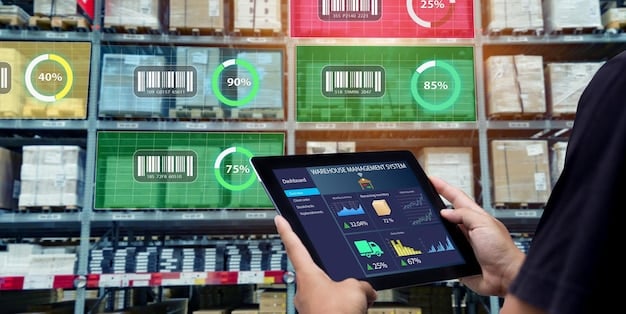Optimize E-commerce Inventory: Reduce Waste by 10% in the US

E-commerce Platform Inventory Management: Optimizing Your US Stock Levels to Reduce Waste by 10% involves implementing strategies and technologies to efficiently manage stock, forecast demand accurately, and minimize overstocking or stockouts, leading to significant reductions in waste and improved profitability for US businesses.
Navigating the complexities of e-commerce inventory management in the US can be challenging, especially when aiming to minimize waste and maximize profitability. This article dives deep into e-commerce platform inventory management: optimizing your US stock levels to reduce waste by 10%, offering actionable strategies and insights applicable to various e-commerce businesses.
Why Is Inventory Management Crucial for US E-commerce Platforms?
Efficient inventory management is more than just knowing what you have in stock. It’s a vital component that directly impacts profitability, customer satisfaction, and operational efficiency. For e-commerce platforms operating in the US, mastering inventory management is crucial for sustaining growth and maintaining a competitive edge.
Poor inventory practices can lead to several costly issues, including:
- Stockouts: Losing sales due to unavailable products.
- Overstocking: Tying up capital in excess inventory and incurring storage costs.
- Waste and Obsolescence: Products becoming unsellable due to spoilage, damage, or becoming outdated.
Let’s explore how effective inventory management can solve these problems and drive success for your e-commerce business.

Key Strategies for Optimizing US Stock Levels
Optimizing your US stock levels requires a balance between meeting customer demand and minimizing waste. This involves implementing several key strategies that focus on accurate forecasting, efficient inventory control, and strategic order management.
Demand Forecasting
Accurate demand forecasting is the cornerstone of effective inventory management. By predicting future demand, you can ensure that you have enough stock to meet customer needs without overstocking.
Inventory Control Techniques
Implementing robust inventory control techniques can help you manage your stock efficiently. These techniques provide real-time visibility and control over your inventory levels.
- ABC Analysis: Categorize inventory based on value and importance.
- Just-in-Time (JIT) Inventory: Receive goods only as they are needed for production or sales.
- Economic Order Quantity (EOQ): Determine the optimal order quantity to minimize total inventory costs.
These strategies help ensure that your inventory is well-managed and aligned with customer demand.
By adopting these key strategies, businesses can significantly reduce waste and improve profitability.
Choosing the Right E-commerce Platform for Inventory Management
Selecting the right e-commerce platform is a critical decision that can significantly impact your ability to manage inventory effectively. The platform you choose should offer robust inventory management features that streamline your operations, reduce errors, and provide real-time visibility into your stock levels.
Essential Inventory Management Features
When evaluating e-commerce platforms, consider the following essential inventory management features:
- Real-time Inventory Tracking: Provides up-to-the-minute information on stock levels across all locations.
- Automated Reordering: Automatically generates purchase orders when stock levels fall below predetermined thresholds.
- Multi-Channel Inventory Management: Synchronizes inventory data across multiple sales channels, such as your website, Amazon, and eBay.
Popular E-commerce Platforms with Strong Inventory Management
Several e-commerce platforms are known for their robust inventory management capabilities. Here are a few popular options:
- Shopify: Offers a range of inventory management apps and integrations.
- Magento: Provides advanced inventory management features for larger businesses.
- BigCommerce: Includes built-in tools for managing inventory across multiple channels.
These platforms can help streamline your operations and improve inventory accuracy.

Implementing Technology Solutions for Waste Reduction
Leveraging technology is essential for optimizing your inventory management and reducing waste. Various tech solutions can streamline processes, improve accuracy, and provide valuable insights into your inventory performance.
Inventory Management Software
Investing in inventory management software can significantly improve your inventory control. These systems provide real-time visibility into your stock levels, automate reordering processes, and offer advanced reporting capabilities.
- Fishbowl Inventory: Designed for small to medium-sized businesses with manufacturing or warehousing needs.
- Zoho Inventory: Offers a user-friendly interface and comprehensive inventory management features.
- QuickBooks Commerce: Integrates seamlessly with QuickBooks for accounting and inventory management.
Automation Tools
Automation tools can help streamline repetitive tasks and reduce the risk of human error. These tools can automate various aspects of your inventory management, such as:
- Order Processing: Automatically processing and fulfilling customer orders.
- Inventory Updates: Automatically updating stock levels in real-time.
- Shipping and Tracking: Automating shipping label generation and tracking updates.
These tools can help streamline repetitive tasks and reduce errors.
By integrating these technological solutions, businesses can significantly reduce waste and improve overall efficiency.
Data Analytics and Reporting for Inventory Optimization
Data analytics and reporting are crucial for making informed decisions about your inventory. By analyzing historical data and tracking key performance indicators (KPIs), you can identify trends, forecast demand, and optimize your stock levels.
Key Inventory Metrics to Track
Monitoring the right inventory metrics can provide valuable insights into your inventory performance. Some key metrics to track include:
- Inventory Turnover Rate: Measures how quickly your inventory is sold and replaced.
- Stockout Rate: Indicates the percentage of time that a product is out of stock.
- Carrying Cost: Represents the total cost of holding inventory, including storage, insurance, and obsolescence.
Using Data to Drive Decisions
Analyzing your inventory data can help you make better decisions about:
- Reorder Points: Determining the optimal reorder points for each product.
- Safety Stock Levels: Setting appropriate safety stock levels to avoid stockouts.
- Promotional Planning: Planning promotions and discounts based on inventory levels and demand forecasts.
These decisions help ensure that your inventory is well-managed and aligned with customer demand.
By using data analytics, businesses can make informed decisions that lead to reduced waste and improved profitability.
Sustainable Practices in E-commerce Inventory Management
Integrating sustainable practices into your e-commerce inventory management is not only environmentally responsible but also economically beneficial. Sustainable practices can help reduce waste, lower costs, and enhance your brand’s reputation.
Reducing Packaging Waste
Reducing packaging waste is a key component of sustainable e-commerce. Consider using eco-friendly packaging materials, minimizing packaging size, and optimizing packaging design to reduce waste.
Reverse Logistics and Returns Management
Efficient reverse logistics and returns management can help minimize waste and improve customer satisfaction. Implement a streamlined returns process, and consider offering incentives for customers to return products in good condition for resale or recycling.
- Offer Returns for Store Credit: Encourage customers to use store credit instead of requesting a refund.
- Consolidate Returns: Minimize shipping costs by consolidating returns and processing them in bulk.
- Refurbish and Resell: Refurbish returned products and resell them at a discount.
These practices can help minimize waste and improve customer satisfaction.
Implementing sustainable practices can benefit both the environment and your bottom line.
| Key Point | Brief Description |
|---|---|
| 📊 Demand Forecasting | Accurate prediction of future demand to avoid overstocking or stockouts. |
| 🧮 Inventory Control | Implementing techniques like ABC analysis and JIT to manage stock efficiently. |
| 💻 Technology Solutions | Using inventory management software and automation tools for better control. |
| ♻️ Sustainable Practices | Reducing packaging waste and improving reverse logistics. |
Frequently Asked Questions
▼
Effective inventory management reduces costs, improves customer satisfaction, and enhances operational efficiency by preventing stockouts and minimizing overstocking.
▼
Key techniques include ABC analysis, Just-in-Time (JIT) inventory, and Economic Order Quantity (EOQ), which help optimize stock levels and reduce waste.
▼
Technology solutions like inventory management software and automation tools streamline processes, improve accuracy, and provide real-time visibility into stock levels.
▼
Important metrics to track include inventory turnover rate, stockout rate, and carrying cost, which help in making informed decisions about inventory levels.
▼
Sustainable practices include reducing packaging waste, implementing efficient reverse logistics, and offering incentives for product returns in good condition.
Conclusion
Optimizing e-commerce platform inventory management in the US to reduce waste by 10% requires a strategic approach combining accurate forecasting, efficient inventory control, technology solutions, data analytics, and sustainable practices. By implementing these strategies, e-commerce businesses can enhance profitability, improve customer satisfaction, and contribute to a more sustainable future.





